If you start to analyze from the very beginning, the causes and consequences become clear. For example, when setting tasks for the current study, it became clear to me that:
Firstly, the choice of materials is due to past experience from childhood.
Artist History
Unlimited access to the father's workshop, work with wooden crafts and old objects found in the attic of our old house in the countryside, past memories, experiences and social habits have a critical impact on my character, priorities and aspirations. I already mentioned earlier that the choice of materials for Phyllida Barlow, for instance also was shaped by her family history. Her mother sewed and did needlework. Working in haste, using everything that was at home, taught the artist to see resources for creative expression in everything. Homemade, Phyllida Barlow [online] At: https://art21.org/watch/extended-play/phyllida-barlow-homemade-short/ (Accessed 28.02.2023)
Before analyzing any other choice of subjects and means of work, it seems to me that the artist's own history is the key to the psychology of his subsequent work.
Secondly, the psychological confrontation against the system.
This is perhaps the most difficult element of recognition in my work, which I learned about only after analyzing the teaching path of Phyllida Barlow. In one of the interviews, Barlow says that she was not good in the traditions of sculpture, it was limiting her artistic search. Therefore after she became a teacher she would rather support a student to go his/her own way to open idiosyncratic qualities of the idea. Homemade, Phyllida Barlow [online] At: https://art21.org/watch/extended-play/phyllida-barlow-homemade-short/ (Accessed 28.02.2023)
This kind of work from denial made me think about what I'm doing. The first reason I work with such controversial material is the desire to do something different from what everyone else is doing. And it seems to me that this is caused by the opposition, first of all, to the system that brought me up. Probably I'm not talented or special, but I can work hard, I can reflect on what I did and I have a big advantage and I enjoy it.
I will analyze my pleasure in more detail on the examples of my next two works. But here it should be noted that my pleasure lies in the totality of "big" messy work, "search for solutions", creating something that has not yet been in the world, working with "potential objects", and creating new (my) aesthetics.
Now I will return directly to working on my opposition through the materials.

I made the first draft of this work in July 2022. Since then, this beginning has been hanging out in my studio. Changing the place from prominent to hidden. The first iron grating solution with a square box was so good that I think that's what stopped me. I couldn't find a solution on how to maintain this communication between objects without destroying it.

I can’t say exactly how ideas appear, but one came. Just support the structure itself with wooden sticks, of which I have already accumulated enough, and inside the composition, contrast this simplicity with chic copper-coated paper.

In such a comparison of chic and primitiveness, I saw an allegory of my country. People sit in shiny cages of high-rise buildings, and everything around them rots and falls apart.
This is not only a visual comparison but also a conceptual one. If we match this art with that which is "understandable", for example, landscapes in the Tretyakov Gallery, this is a confrontation in the materials.

At home, 2023, recycled wood, metal, concrete, burlap, copper-coated paper, cardboard, newspapers; acrylic paint, sand, screws, nails, 63 x 72 x 66 cm.
There is the same wood as the wooden frame of the painting from the museum. Here is a canvas, the same canvas as the one on which the field and the sky are painted. Here is the same subtle play of tones and paint colours. I am interested in just such a search for comparisons, what happened to the material? How has our perception changed now? And it is precisely this contradiction in approaches, the awareness of understanding of the essence of things, critical thinking, and the breadth of perception of possibilities that interests me in the transfer of simple, everyday materials.
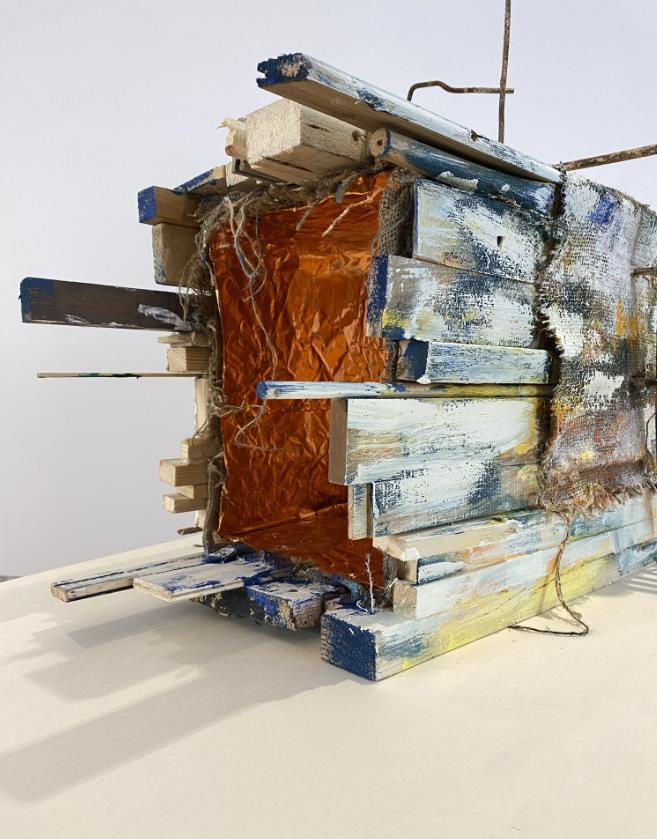
There is no need to look for aesthetic beauty, although for me this is it. In this work, I propose to turn to my history and the constant system where I grow up and why I'm not there anymore. My inner subjective perception of this world says that breaking stereotypes is good. Trying contrasts is helpful. Therefore, for me, the use of the building and found materials has become a psychological reaction to a closed, outdated, old system of perception of the world and art in particular.
Thirdly, even found materials, I choose carefully and not all materials are aesthetically attractive
Сollaboration
After a successful collaboration with one of the OCA colleagues, I was invited to the OCA Social Photography Club. It was motivating to work together and connect two worlds - photography and sculpture.
At the first session, photographers presented their work, explaining their motivation, tasks and methods of work. During our meeting, I caught myself thinking that some works and topics were of no interest to me. Simply put, they didn’t bother me at all, the colour was sad, the compositions were simple and not exciting, the topic was almost unpleasant for me (flea market, homeless people), and I wanted to crop the shown photos around the edges to make them look better. Now, analyzing this situation in hindsight, I think maybe that's why I liked the following works so much. Because good works were presented to me in contrast.
Photographer Luke Shephard presented his new series of street photography. He explained the peculiarity of this work as "capturing the moment", "you have only one opportunity"... And this, in my opinion, makes such pictures invaluable - this moment will never happen again. The captured facial expressions of people, their postures, and situations add up to whole stories and books.

So one photo mesmerized me. It depicted a father and daughter. Perhaps I am so touched by this because it resonates with my family tragedy. But I couldn't help thinking about this photo, and as a reaction, I needed to reflect on it. In addition, this experience is incredibly supportive of my ongoing research - what attracted me to this photo? What provoked such a reaction?
Allure
Philosopher Graham Harman proponent of "Object-oriented ontology" explains the attraction of objects by allure.
"The separation between a sensual object and its quality can be termed ‘allure.’ This term pinpoints the bewitching emotional effect that often accompanies this event for humans, and also suggests the related term ‘allusion,’ since allure merely alludes to the object without making its inner life directly present." COLLAPSE II On Vicarious Causation, Graham Harman [online] At: https://community.stjohnscollege.edu/file/chapter/chapter-readings/harmanvicarious-causation.pdf (Accessed 28.02.2023)
As far as I understand this idea, objects, including humans, are simply suitable for each other. Some external attractiveness of an object attracts another. “There are countless examples of allure. In instances of beauty, an object is not the sum total of beautiful colors and proportions on its surface, but a kind of soul animating the features from within, leading to vertigo or even hypnosis in the witness.” COLLAPSE II On Vicarious Causation, Graham Harman [online] At: https://community.stjohnscollege.edu/file/chapter/chapter-readings/harmanvicarious-causation.pdf (Accessed 28.02.2023)

Objects are connected to each other according to some aesthetic principles. For me, in this case, the internal emotional tension worked. In connection with the events of the war, there were terrible breaks in my family, and the moment when I saw this black-and-white story in the photo, it became the personification of my feelings. There was a reaction, allure.
Further, this inner feeling had to be transferred back to the outer manifestation. And here it is as if I am building a metaphor in reverse. Herman turns to metaphor as a way to cleanse an object of unnecessary properties and point to its true essence.
Metaphor - an expression, often found in literature, that describes a person or object by referring to something that is considered to have similar characteristics to that person or object Cambridge dictionary [online] At: https://dictionary.cambridge.org/dictionary/english/metaphor (Accessed 19.03.2023)
«Instead, we need an experience in which the sensual object is severed from its joint unified quality, since this will point for the first time to a real object lying beneath the single quality on the surface. For humans, metaphor is one such experience. When the poet writes ‘my heart is a furnace,’ the sensual object known as a heart captures vaguely defined furnacequalities and draws them haltingly into its orbit. The inability of the heart to fuse easily with furnace-traits (in contrast with literal statements such as ‘my heart is the strongest muscle in my body’) achieves allusion to a ghostly heart-object lying beneath the overly familiar sensual heart of everyday acquaintance. Notice that the inverse metaphor is entirely asymmetrical to the first: ‘the furnace is a heart’ draws cardiac traits into the orbit of a sensual furnace, which is freed from bondage to its usual features and evoked as a sort of hidden furnace-soul, one whose animus now powers rhythmic beating and circulation.» COLLAPSE II On Vicarious Causation, Graham Harman [online] At: https://community.stjohnscollege.edu/file/chapter/chapter-readings/harmanvicarious-causation.pdf (Accessed 28.02.2023)
Metaphor in reverse
And if a metaphor purifies to the essence, then can my work be such a metaphor in reverse? In other words, if I speak, my feelings about this photo can be expressed in the form of such artwork.

I started with two figures, these are two wooden boards. This material is not new, perishable, with its own rigid form, but it can be changed. All these qualities fit the description of a person.

One wooden board is small and diligent, the other is dominant in size and with prejudices and stereotypes - paper, metal inserts, rope.

I place both elements on cardboard and wood which give the feeling of multi-unit, multi-level buildings. This is a pedestal for action. The basis for relationships, is the city, with its dynamics and rhythm.

Returning a little to the very process of working on this piece. I do not make pencil sketches, my way of thinking can be presented by some stages of working with an object. When there is a good match of materials and elements, I feel it and leave this part and move on.
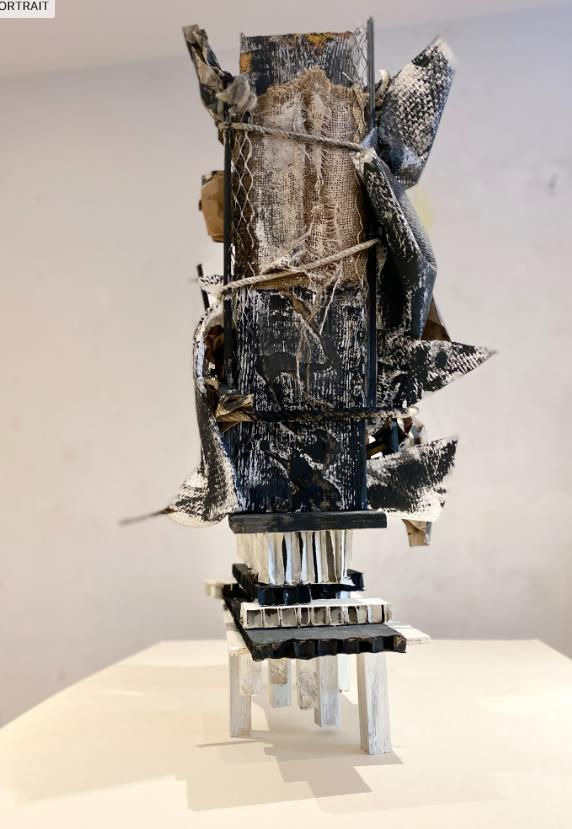
For example, the current work is an excellent example of one such stage. The metaphorical transformation of the dynamics and rhythm of the city into cartons and wooden trimmings turned out to be an incredibly sharp find. At the same time, what happened "on the surface" of this dynamic pedestal was not balanced.

Two large parts on top, personifying a father and daughter, dominated the entire composition and were something formless.
So I decided to take a radical decision.

And it became easier, energy went in the right direction.

I had balls from one of my old works, and they became a good solution to the metaphor about man as the universe.

On the streets, 2023, recycled wood, cardboard, newspapers; acrylic paint, screws, glue, 37 x 48 x 21 cm.
Thus, each of the elements, and the work as a whole, is my reaction to the series of city photographs, built in the form of a metaphor. Therefore, hypothetically, you can call my work a reverse metaphor "On the street". Although I always thought that my work is more abstract content. But it turns out that they are highly narrative.
The second experience of collaboration and my analysis of the choice of materials was the work inspired by the photograph of Mary Kyd from OCA.

And again, I can only note that we react to what resonates in our souls. Graham Harman calls it Allure and the cleansing of objects from unnecessary qualities. That's when we see the pure essence.
I saw light and colour. The simplicity of which the photographer enjoyed. The poetics of a simple sunny day are shown through the organized thinking of a man. Shelves lit by the sun and under them a dog hiding from the heat.
I made it harder for myself. Because I only needed to focus on the emotions, I didn't see the photo again until the sculpture was complete. I was interested in that first state, the first reaction, the delight of what I saw. In my memory, the impression of a bright pink colour remains. Now I think that only this colour was the trigger of my work. I mixed several different colour options just to achieve this particular colour, which was the bright spot in my head.

Rack, 2023, recycled wood, fur; acrylic paint, screws, plaster, 73 x 53 x 39 cm.
Now you can imagine my shock when I saw the white shelf. It turns out my brain played a trick on me. Isn't that what I was looking for?
My impression of a photo of a sunny day came through a small jar of brightly unnatural pink colour. It turns out that this is the essence of perception. My brain grabs onto something so small, unsteady and only visible to me. At the same time, I understand that without the general atmosphere of a sunny day, this pink element would not have worked either. It was definitely an allure. All uselessness was discarded and a sunny day was perceived through a bright toxic pink colour.
For my analysis of the choice of materials, it is important to track my choice.
The artist Gabriel Orozco in his work "Working Tables" denotes the meaning of the remains of the work in the artist's studio. Thus translating seemingly unnecessary recycled materials into evidence of the artistic process. And after that, endowing these leftovers with a new meaning. These leftovers become new work, and new leftovers appear, and more and more and more leftovers. Such a multi-layered cake of evidence of the artist's activities. It turns out that all objects are interconnected by a certain history. And in doing so, new meanings appear.

MOMA, Gabriel Orozco. Working Tables, 2000-2005. [online] At: https://www.moma.org/audio/playlist/240/3094 (Accessed 20.03.2023)
The artist also points to what I call "object hints" - where the materials kind of communicate with me and tell me how they will look better or what they want to interact with.
«What I'm after is the liquidity of things, how one things leads you on the rest... The works are about concentration, intention, and paths of thought: the flow of totality in our perception, the fragmentation of the "river of phenomenon".» The Art Story. Orozco Gabriel [online] At: https://www.theartstory.org/artist/orozco-gabriel/ (Accessed 20.03.2023)
Such a description of the activity of modification and changing could be improved with the theory of symbiosis by Lynn Margulis.
“To Margulis, it was not a given that ... (cells with nuclei) are individual entities. She viewed them as populations, composed of vestiges of organisms...” SCIENCE Lynn Margulis: Science's Unruly Earth Mother 19 Apr 1991 Vol 252, Issue 5004 pp. 378-381 [online] At: https://www.science.org/doi/10.1126/science.252.5004.378 (Accessed 20.03.2023)

Lynn Margulis: Science's Unruly Earth Mother [online] At: https://www.science.org/doi/10.1126/science.252.5004.378 (Accessed 20.03.2023)
In other words, the change of a thing does not occur from within, not as it was previously thought that the fittest gene or organism would survive and be modified. The change happens due to interaction with the outside. I am close to this approach in its essence. To change, you need to interact with the outside world.
So by combining these two approaches, Orozco's focus on leftovers and blending them together with something outside the norm (outside the species type) to create a "better gene" for evolution, I get a new mix.
Leftovers of previous works exist in my studio, but these "out-of-species objects" also appear in my studio by very detailed selection.
Material selection for the studio
I noticed that not all materials for recycling suit my aesthetic taste.

The best place to choose working materials is a hardware store. The smell of wood fascinates me. Cleanliness and tidiness of choice. Working with pieces of wood implies a lot of active actions with the body. Saw, chop, plan, grind, drill. It must be "flesh and blood" to make a new body out of it. It's like giving birth to a child that I can't have. This is my opportunity to bring to this world something that has not been here before - this is pure pleasure in my work. This is a "large" activity that is opposed to the sitting image of pencil drawing for example. The whole physical being is involved in the activity.
Potential objects

Second, a good place to collect material for work is metalwork workshops and construction warehouses for processing.

With all the appearance of disorder and great disorganization, in these places, the objects are carefully sorted.

There are objects with history, the legs of an old chair, a cleaned, but old grating with elements of concrete remnants, and so on.
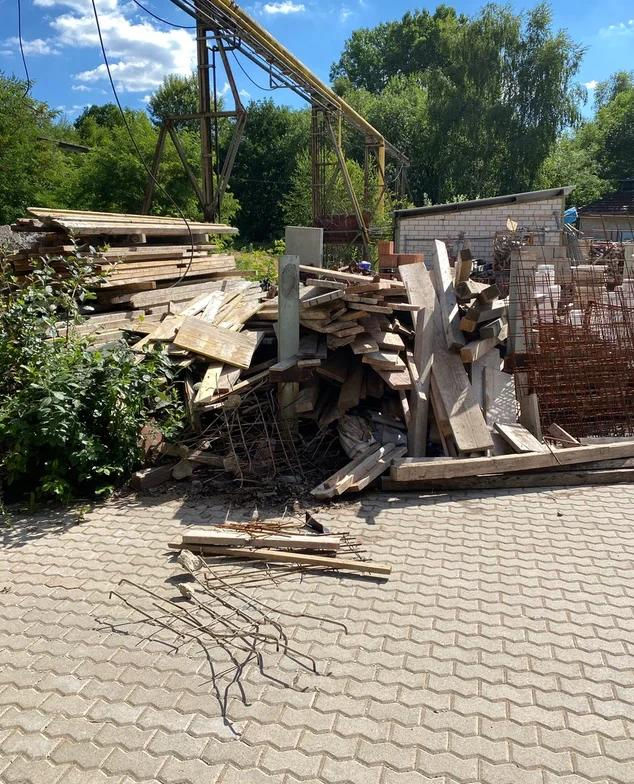
These are "potential objects". They can be remade into new ones, become integral elements of the new. They have the potential to continue transmitting the information. Their history, inscribed in their qualities, is unique and can be read in the future. At the same time, old plastic materials for insulation, non-natural elements of ventilation systems and other unpleasant objects begin to be found in such places. Rarely can a plastic be endowed with an individual unique story. Even after 20 years in the ocean, a plastic bag will still be a plastic bag. And if you compare a 20-year-old piece of wood in salty water - it can be exciting.
Here, perhaps, Allure, described by me above, intervenes in the choice of subjects. Perhaps this is exactly what I feel when choosing my studio objects. This is a kind of euphoria, the purity of the essence of the subject, which I see. But on the other hand, maybe I am guided precisely by the potential of this object...
What are unpleasant objects? Objects cleanliness, which I doubt. This is what disgusts me and makes it unthinkable for me to work with such material. This subjective feeling is exactly what, perhaps, distinguishes my art so much. It turns out such a very thin border of selection from attractive objects and not.

And the third place, where I would rather not find anything, but sometimes it happens, is a place of reconstruction. All objects here seem to be dead, meaningless. They served for something up to a certain point, and then they lost their meaning. These are very different objects than "potential objects". Such objects are not endowed with features. They are devoid of individuality and cannot bring value to future new combinations of objects.
Coming back to my second reaction to the photo.

In the first sketch, a strong structure immediately appeared, the basis of the whole composition, but the small elements were not in place.

Since my memories of light and colour were the basis, I decided to draw a shadow on the sculpture and see what happens.
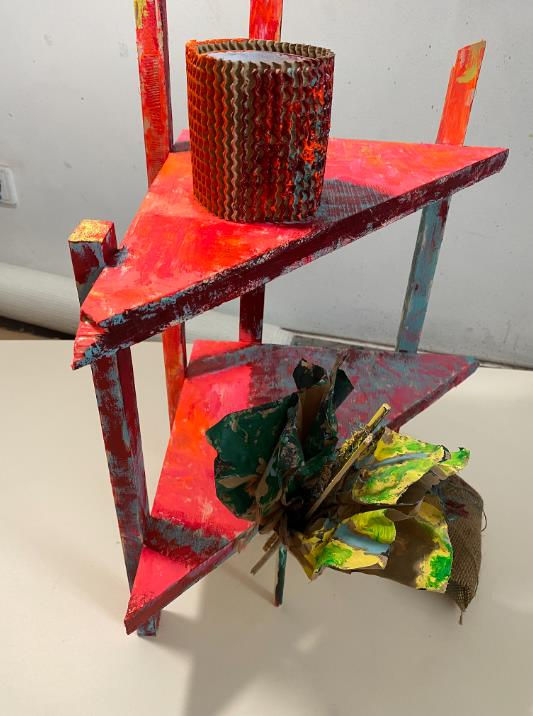
Did not work. There is no focus on one thing, there is a shadow and colour and objects - its a horror!

And again, a radical removal of all unnecessary elements.
Search for ideas with an already existing form.

A small step towards the right decision to convey the feeling of the item on the shelf.

A funny object test for an object. It reminded me of a series of works by Phyllida Barlow "Object for ..." An object understood in relation to another object. This topic is for separate consideration. But like this, in the process of finding a solution for one object, many new ideas appear on the way.

Phyllida Barlow, Object for the television, 1994 © Phyllida Barlow [online] At: https://www.hauserwirth.com/ursula/31536-phyllida-barlow-the-edges-of-things/ (Accessed 20.03.2023)

And the culmination was the almost Freudian embodiment of the subconscious through the methods of Dali.

The dog hiding from the sun has discarded all necessary qualities and has become what we love animals for - because they are fluffy.
I consider this the apogee of the curved work of the brain. Firstly, I remembered the white shelf as toxic pink, and secondly, the dog became important as much as it has fur.
Bibliography and references
1. COLLAPSE II On Vicarious Causation, Graham Harman [online] At: https://community.stjohnscollege.edu/file/chapter/chapter-readings/harmanvicarious-causation.pdf (Accessed 28.02.2023)
2. Graham Harman 2017 Object Oriented Ontology: A New Theory of Everything Publisher: Penguin Random House
3. Boris Klyushnikov - I. KANT "Criticism of the ability of judgment" [online] At: https://youtube.com/watch?v=hEIJN5aUCPc&si=EnSIkaIECMiOmarE (Accessed 01.03.2023)
4. Graham Harman: Anthropocene Ontology https://youtube.com/watch?v=cR1A4ILPmjE&si=EnSIkaIECMiOmarE (Accessed 01.03.2023)
5. Phyllida Barlow 2021 Frontier. Damian Lentini. Haus der Kunst Munich. Hirmer





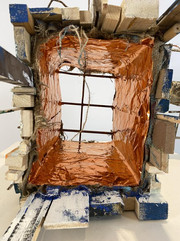






















Comments